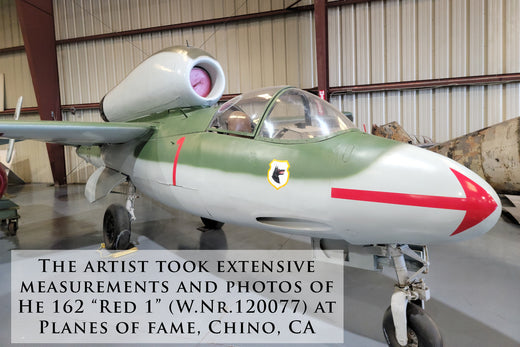This Fine Art Print by Artist Craig Tinder showcases an incredibly rare Luftwaffe Jet Aircraft - the Heinkel He 162 A-1 Volksjäger ("People's Fighter"). Depicting one of the only engagements (and even contested) of the He 162 at the end of the war, this advancement in jet technology further propelled aviation to new levels.
 Artist Craig Tinder with Contested Victory - He 162 Salamander Canvas Print
Artist Craig Tinder with Contested Victory - He 162 Salamander Canvas Print
Details About the RELIC:
These original He 162 components were provided by D. Lemp in partnership with the Rechliner Museum and are left-over remnants from the restoration of the He 162 on display at the Aviation Technical Museum in Rechlin, Germany.
 Restored He162 Salamander "White 4" - Aviation Technical Museum
Restored He162 Salamander "White 4" - Aviation Technical Museum
Following the withdrawal of Soviet forces from East Germany in the 1990s, long-inaccessible areas previously used by the German military during World War II became available for exploration. These sites, including former war production facilities and airfields, yielded numerous artifacts from Germany’s late-war aviation projects. Among the most significant finds were crates of parts of the Heinkel He 162, a rare jet fighter developed during the final months of the war. Although Soviet forces took the BMW 003 jet engines to the Soviet Union for testing, the majority of airframes and components were left behind. These parts had been stranded at various locations by the departing Russians, waiting to be uncovered.
 He162 Salamander relics
He162 Salamander relics
 He162 Salamander relics
He162 Salamander relics
Large portions of original He 162 components were recovered from former production facilities, including the main Heinkel plant in Rostock, which had been heavily bombed during the war. To disperse production, the Germans established smaller, more concealed sites in Mecklenburg, including a factory hidden in the forest near Rövershagen and another at the Barth airfield on the Baltic Sea. These sites were key locations where many He 162 parts were manufactured.
 Heinkel Factory - Rostock Germany
Heinkel Factory - Rostock Germany
Parts found at these sites have since been used to rebuild several He 162 aircraft, including the one currently displayed at the Aviation Museum in Rechlin. Though most wooden components had to be reconstructed, much of the original structure remains intact, showcasing the ingenuity and desperation of late-war German aircraft production. Among the items recovered were cockpit components, armored plates, and original production tools such as drilling templates.
 Restored He162 Salamander "White 4" - Cockpit
Restored He162 Salamander "White 4" - Cockpit
 Restored He162 Salamander "White 4" - Front Landing Gear Bay
Restored He162 Salamander "White 4" - Front Landing Gear Bay
With just over 300 built before the end of the war, only 110 were actually delivered to the Luftwaffe. Only seven original aircraft remain to this day, with an additional four replicas built using original parts from this cache - making these pieces incredibly rare. Each relic included with the print originate from the cockpit and nose gear section of the He 162 Salamander.
 Remaining He162 Salamander components acquired by Aces In Action
Remaining He162 Salamander components acquired by Aces In Action
The Story Behind the Print:
4 May 1945 - Lt. Rudolf Schmitt, a Luftwaffe pilot flying the Heinkel He 162 "Volksjäger," engaged in one of the few documented aerial combat missions involving this late-war German jet fighter. During this encounter, Schmitt reportedly shot down a British Tempest V, piloted by Lt. Tom Austin of the 486 Squadron, Royal New Zealand Air Force (RNZAF). The He 162, designed as a last-ditch effort by Nazi Germany to defend against the overwhelming Allied air superiority, was one of the most advanced jet fighters of its time, though it saw very limited combat action before the war ended.
This particular engagement is significant due to the rarity of He 162 missions, with most Luftwaffe jets either grounded due to fuel shortages or destroyed on the ground by Allied bombing raids. The battle took place just days before Germany's surrender, during a period of chaos and desperation as the Luftwaffe's capabilities dwindled. The He 162, nicknamed the "Volksjäger" or "People's Fighter," was developed quickly, with young and inexperienced pilots, including Schmitt, flying the aircraft in the face of overwhelming Allied forces.
After the engagement, a German flak (anti-aircraft) unit also claimed responsibility for downing Austin's aircraft, leading to confusion over who deserved credit for the kill. Despite this, Lt. Austin, who survived the crash and was taken prisoner, supported Schmitt’s claim, insisting that the jet fighter, not flak fire, was responsible for bringing down his Tempest V. This testimony provided a rare confirmation of a jet-to-jet victory by the He 162, a remarkable feat considering the aircraft’s rushed production and limited operational use.
The incident remains one of the few confirmed victories by the He 162 in its brief operational history, making it a noteworthy moment in the final stages of World War II’s aerial warfare.
 He 162 "Red 1" (W.Nr. 120077) at Planes of Fame in Chino, California
He 162 "Red 1" (W.Nr. 120077) at Planes of Fame in Chino, California
In preparation for this art print, Artist Craig Tinder visited and thoroughly researched the only He 162 on public display in the United States - He 162 "Red 1" (W.Nr. 120077) at Planes of Fame in Chino, California.
Learn more about How the Heinkel He 162 Redefined Aircraft Design in Breaking Norms? Click Here
To purchase or see similar items, visit here.
Commissioned by Museums, Treasured by Collectors





Share:
Wings of Sacrifice, the story behind "Crossing Through The Canyon"
Silent Watch, the story behind "Tomahawk Patrol"